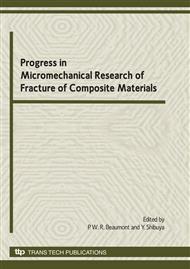p.19
p.31
p.41
p.47
p.53
p.69
p.83
p.101
p.115
Damage Mechanism and Apparent Fracture Strength of Notched Fiber-Reinforced Composite Laminates
Abstract:
Apparent fracture strength of notched fiber-reinforced composite laminates depends on the notch tip radius even if it is evaluated in terms of the local parameters such as the stresses at a notch tip or the stress intensity factors. Although numbers of phenomenological explanations have been made, this phenomenon has not yet been physically clear enough. In order to elucidate its key mechanism, our interest is here focused on the interlaminar crack extension from a notch tip in cross-ply laminates subjected to mode-I loading. We find a stochastically expected upper bound of interlaminar crack length due to the probabilistic breakage process of fibers in load-bearing laminas inside the delaminated zone. This upper bound, i.e., the critical length of interlaminar crack, is inherent to the laminate and corresponds to its notched strength. The well-known variation in apparent fracture strength of notched fiber-reinforced composite laminates with respect to the notch tip radius is clearly explained as the scale effect of this constant critical length in different displacement distributions ahead of notch tips of different radii.
Info:
Periodical:
Pages:
53-67
Citation:
Online since:
March 2010
Authors:
Price:
Сopyright:
© 2010 Trans Tech Publications Ltd. All Rights Reserved
Share:
Citation:


